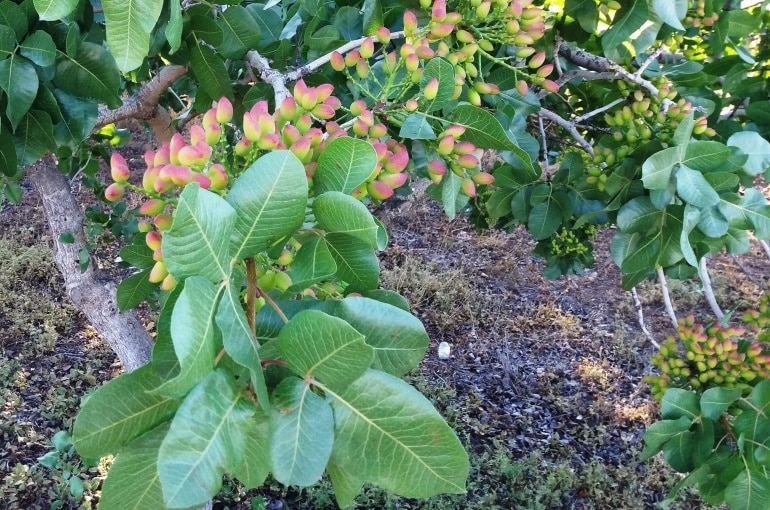Pistachio Tree Fertilizer Requirements

This post is also available in:
This post is also available in:
![]() Español (Spanish)
Español (Spanish) ![]() Français (French)
Français (French) ![]() Deutsch (German)
Deutsch (German) ![]() Nederlands (Dutch)
Nederlands (Dutch) ![]() العربية (Arabic)
العربية (Arabic) ![]() Türkçe (Turkish)
Türkçe (Turkish) ![]() 简体中文 (Chinese (Simplified))
简体中文 (Chinese (Simplified)) ![]() Italiano (Italian)
Italiano (Italian) ![]() Português (Portuguese (Brazil))
Português (Portuguese (Brazil))
Pistachio Tree Fertilization – How to fertilize Pistachio Trees
Nitrogen is the major element required for proper shoot growth and good yields. Nitrogen deficiencies often result in excessive defoliation during the productive period and hence decrease in nut yield. If a nitrogen deficiency is diagnosed, farmers often apply N-P-K 32-0-0 through the irrigation system, with increasing rate each year as the trees mature (ask a licensed agronomist).
Phosphorus and potassium deficiencies have been found to reduce the production and quality of pistachio trees. The minimum level of potassium in the leaves (in order to avoid a summer deficiency) is 0.7 to 0.9%. The minimum leaf level of phosphorus is from 0.09 to 0.1%. Moreover, it has been found that the pistachio trees are infected by Verticillium dahliae more easily when there is a potassium and /or phosphorus deficiency.
A common pistachio fertilization scheme involves adding 8-12 lbs. (3,6 – 5,4 kg) of N-P-K 12-12-17 +2MgO per every mature tree during late winter – early spring (February-March) and the injection of water soluble fertilizer N-P-K 15-15-15 through the irrigation system during spring (April-May). In cases of Potassium deficiencies that often result in high percentage of empty nuts, farmers often add 250 lbs. (113 kg) per hectare of K20 during summer (June-July). Keep in mind that 1 hectare = 2,47 acres = 10.000 square meters and 1 ton = 1000 kg = 2205 lbs.
Excellent fertilization of pistachio tree can be managed by adding manure. Many farmers add 10 to 20 tons of manure per hectare every one or two years. (1 hectare = 10.000 square = 2,47 acres). When they cannot find manure at a reasonable price, many farmers apply green manure, mainly Vicia faba. In this case, pistachio farmers sow legumes in the autumn. During the next few months, they add phosphorus and potassium to the pistachio farm in order to help legumes grow quickly. They finally plow the plants, incorporating them into the soil just before their flowering (spring –April, May) and definitely before letting the legumes compete with pistachio trees in water. Keep in mind that during the decomposition of organic matter, there is increased nitrogen consumption. Consequently, many farmers add -at the time of plowing- nitrogen (in nitrate form) to the soil so as to avoid any nitrogen deficiency (ask a licensed agronomist).
However, these are just common patterns that should not be followed without making your own research. Every field is different and has different needs. Checking the soil nutrients and pH is vital before applying any fertilization method. As it also happens in nearly all fruit trees, leaf analysis is very important in order to diagnose and correct nutrient deficiencies. Pistachio tree needs at least a dozen elements in order to stay healthy and thrive, but your trees may not need fertilization at all. There are cases in which pistachio growers have not applied any fertilization method for years, and they still consistently harvest good yields.
You can enrich this article by leaving a comment or photo of your pistachio trees fertilization method.
1.) Pistachio Tree Information
2.) How to grow Pistachio Tree from nut
3.) Starting a Pistachio Orchard
4.) Pistachio Tree Growing Conditions
5.) Pistachio Tree Propagation and Pollination
6.) Pistachio Tree Soil Conditions and Preparation
8.) Pistachio Tree Training and Pruning
9.) Pistachio Tree Fertilizer Requirements
10.) Pistachio Tree Water Requirements
11.) Pistachio Tree Harvest & Yields
12.) Pistachio Tree Diseases & Pests
Do you have experience in Pistachio Tree cultivation? Please share your experience, methods and practices in the comments below. All the content you add will be soon reviewed by our agronomists. Once approved, it will be added to Wikifarmer.com and it will influence positively thousands of new and experienced farmers across the world.








































































